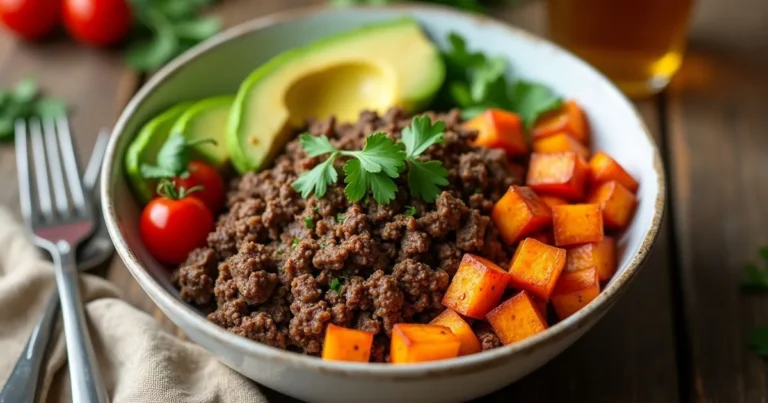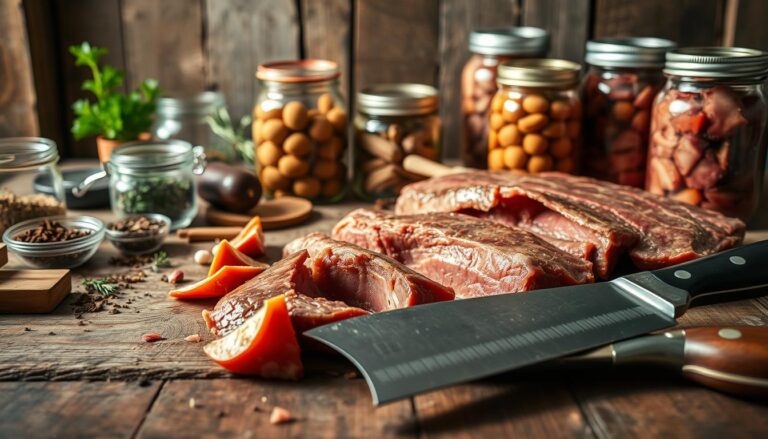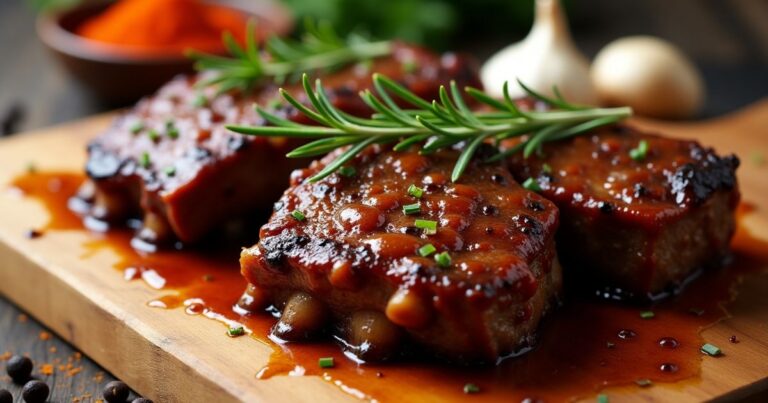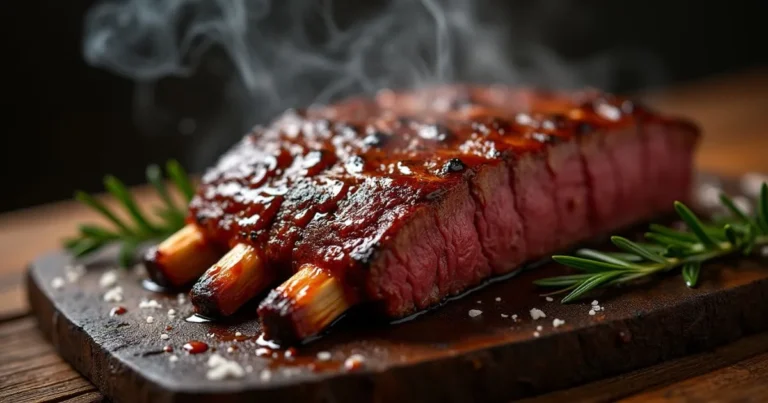Lean Ground Beef: What’s the Best Choice in 2025?

Imagine you’re in the meat section, feeling lost among all the ground beef options. Looking for a healthy choice isn’t just about taste. It’s about making good nutritional choices for your family. Lean ground beef has become a key health option in 2025.
With health trends changing, picking the right low-fat meat is more important than ever. Ground beef is not just protein; it’s a versatile ingredient that can elevate your meals. It supports your health goals, whether you’re into fitness or just want to cook healthier meals.
This guide will help you understand ground beef better. We’ll cover fat percentages, cooking methods, and health benefits. Start your journey to healthier meals here.
Key Takeaways
- Lean ground beef offers multiple health-conscious options
- Fat percentages dramatically impact cooking and nutrition
- Selecting the right ground beef depends on your dietary goals
- Cooking techniques vary based on meat’s lean-to-fat ratio
- Understanding labels helps make informed food choices
Understanding Ground Beef Percentages and Labels

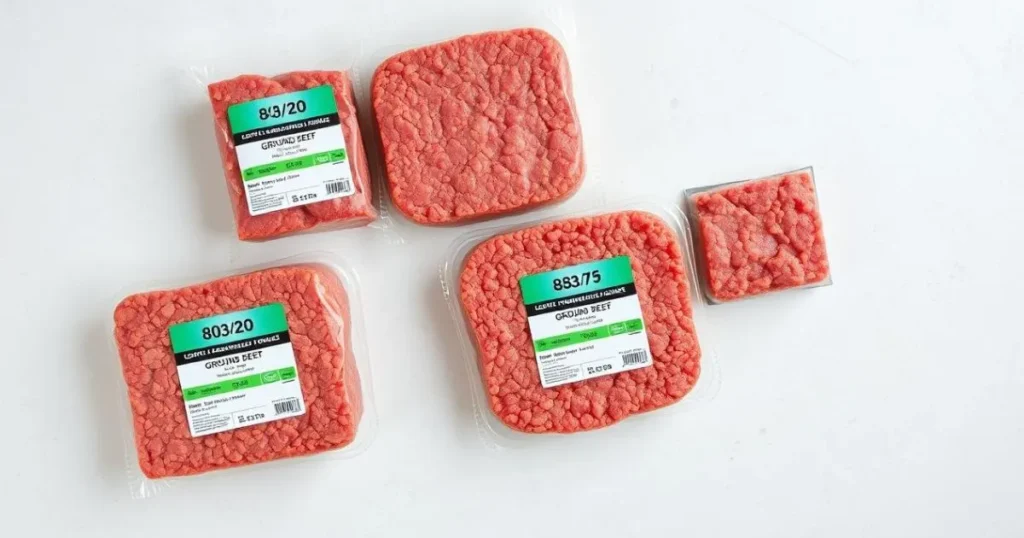
When you’re shopping for ground beef, those numbers on the package can seem confusing. Ground beef nutrition starts with understanding lean-to-fat ratios. These ratios tell you exactly what you’re bringing home from the store.
The percentage you see represents the lean protein content versus fat. For instance, an 85/15 ground beef package means 85% lean muscle and 15% fat. This ratio dramatically impacts both nutritional value and cooking performance.
Decoding Lean-to-Fat Ratios
Different ground beef percentages serve unique culinary purposes:
- 73/27: Best for juicy burgers and flavorful dishes
- 85/15: Balanced option for multiple recipes
- 93/7: Ideal for health-conscious cooking
USDA Standards and Classifications
The USDA provides strict guidelines for ground beef classifications. These standards ensure consumers understand exactly what they’re purchasing, from fat content to meat quality.
| Beef Percentage | Fat Content | Recommended Use |
|---|---|---|
| 73/27 | 27% Fat | Burgers, Meatballs |
| 85/15 | 15% Fat | Tacos, Stuffed Peppers |
| 93/7 | 7% Fat | Stir-Fries, Light Dishes |
Common Market Labels Explained
Labels like “grass-fed beef” offer additional insights. Grass-fed beef typically contains higher omega-3 fatty acids and antioxidants compared to grain-fed alternatives. Understanding these labels helps you make informed nutritional choices.
“Know your meat, know your meal” – Culinary Wisdom
By understanding ground beef percentages, you’ll select the perfect lean protein for every recipe. This balances flavor, nutrition, and cooking performance.
Lean Ground Beef: Nutritional Benefits and Health Impact
Knowing about beef nutrition is key for a healthy diet. Ground beef is packed with nutrients that support your health. A 3-ounce serving of lean ground beef is a nutritional powerhouse.
Lean ground beef is rich in:
- High-quality protein (24g per 3-ounce serving)
- Essential minerals like iron and zinc
- Vital B-vitamins, including B12 and B6
- Low in carbohydrates
For those looking for healthy beef recipes and weight control, lean ground beef is a good choice. The 95/5 ground beef is great for less fat and more nutrients.
| Beef Lean Ratio | Calories | Total Fat | Protein |
|---|---|---|---|
| 97% Lean/3% Fat | 130 | 3.8g | 26.1g |
| 90% Lean/10% Fat | 184 | 10g | 24g |
Tip for smart beef consumption: Choose leaner cuts to get more nutrients and less fat.
“Quality protein is essential for muscle maintenance and overall health” – Nutritional Experts
When adding ground beef to your meals, pick cooking methods that keep nutrients in. Grilling, broiling, and using little oil are good choices. They help you enjoy the protein without extra fat.
Best Uses for Different Fat Percentages
Knowing the fat content of ground beef can change how you cook lean beef meals. Not all ground beef is the same. Using different fat percentages can make your cooking better.
Ground sirloin and other beef cuts have different fat ratios. These ratios affect flavor, texture, and how well they cook. Let’s see how different fat percentages can make your dishes better.
73/27 Ground Beef: Flavor-Packed Dishes
73/27 ground beef has the most fat. It’s perfect for dishes that need rich flavor and moisture:
- Juicy burgers with maximum flavor
- Hearty meatloaf with exceptional tenderness
- Flavorful chili and shepherd’s pie
“The higher fat content helps retain moisture and creates incredibly delicious meals.” – Chef Culinary Expert
85/15 Versatile Cooking Options
This mix is great for many cooking methods:
- Classic tacos with balanced flavor
- Tender meatballs
- Robust spaghetti sauce
- Stuffed peppers with perfect texture
93/7 Lean Preparation Methods
For those watching their fat intake, 93/7 ground beef needs careful cooking:
- Stir-fries with minimal added fat
- Light chili recipes
- Pasta sauces with reduced calories
Pro tip: When using leaner ground beef, add moisture-rich ingredients like diced vegetables or broth to keep it moist.
Cooking Tips and Techniques for Ground Beef
Learning to cook lean beef meals is all about precision and technique. Whether you’re making healthy beef recipes or a quick dinner, knowing how to cook ground beef can improve your cooking skills.
When using leaner ground beef, keeping it moist is key. Here are some expert tips to keep your dishes juicy and full of flavor:
- Add moisture-rich ingredients like broth or breadcrumbs to prevent drying
- Use recommended seasoning ratios: 0.5 teaspoons each of onion and garlic powder
- Cook ground beef at optimal temperatures to retain tenderness
Cooking times depend on your method:
- Stovetop: 7-10 minutes for one pound
- Instant Pot: Approximately 6 minutes under high pressure
- Oven: 25-30 minutes at 400°F
For lean beef meals, try the 85/15 ground beef ratio. It’s a great mix of flavor and health. Use homemade taco seasoning (1.5-2 tablespoons per pound) to add flavor without extra fat.
Remember, proper seasoning and moisture management are key to transforming lean ground beef into delectable dishes.
When storing cooked ground beef, refrigerate it for 3-4 days. Or freeze it in a sealed container for longer. By following these tips, you’ll make delicious, healthy meals every time.
Selecting and Storing Lean Ground Beef
Choosing the right grass-fed beef is key for nutrition and taste. When you pick ground beef, it greatly affects your meal’s quality and nutrition.
Here are the main signs of high-quality ground beef:
- Bright red color signaling freshness
- Firm, consistent texture
- Recent packaging date
- Clean, uniform appearance
Local butchers usually offer better ground beef than pre-packaged ones. About 70% of people now choose nutrient-rich meats. So, picking carefully is more crucial than ever.
Fat content is important in choosing beef:
- Extra lean: 10% fat or less
- Lean: 15% fat or less
- Standard: Up to 30% fat
Proper storage is also vital for keeping beef quality. Refrigerate ground beef at 40°F or below. Use it within 1-2 days. For longer storage, freeze it right away. This can keep meat fresh for up to 4 months.
Pro tip: Local sourcing supports community farmers and can reduce contamination risks by up to 50%.
By following these tips on selection and storage, you’ll get tasty, healthy meals every time.
Sustainable and Ethical Considerations in Beef Production
It’s important to know about the environment and ethics in beef making. Choosing grass-fed beef can help a lot. It supports good farming and animal care.
Grass-fed beef is good for you and the planet. Cattle on pastures help the soil and fight climate change. They also live better than those in feedlots.
- Grass-fed beef has more lean protein and omega-3s
- Pasture-raised cattle help farms grow back
- Good farming lowers harm to the environment
Nutritional benefits of grass-fed beef include:
- More nutrients
- Better omega-3 to omega-6 ratio
- More vitamins A and E
Grass-fed beef is pricier, costing 20-30% more. This is because it takes longer to raise, needs more land, and is harder to manage.
Choosing sustainable beef isn’t just about nutrition—it’s about supporting responsible agricultural ecosystems.
Your choices can make a big difference. They help ranchers who care about animals and the planet.
Conclusion
Exploring protein options in 2025, lean ground beef stands out as a healthy choice. It makes up 50.6% of beef’s retail market value. Knowing its nutritional profile is key for making good food choices.
Discovering lean ground beef options shows many benefits. For example, 90/10 ground sirloin has 20g of protein per 100 grams. It’s also great for cooking in many ways. This protein helps build muscle and boosts overall health.
Choosing the right lean ground beef depends on fat percentages, cooking methods, and health goals. Ground beef is a favorite in 75.3% of U.S. homes. It’s versatile and can be part of many meals, keeping your diet balanced.
The ground beef market is growing, offering better options for those who care about health. By picking, preparing, and enjoying lean ground beef wisely, you can make it a key part of your meals.
FAQ
What does the lean-to-fat ratio mean in ground beef?
The lean-to-fat ratio shows how much lean meat to fat is in ground beef. For example, 93/7 means 93% lean meat and 7% fat. This ratio affects the beef’s nutrition, taste, and how it cooks. Lower fat means juicier dishes, while higher lean is better for health.
Is lean ground beef healthy?
Yes, lean ground beef is full of protein and nutrients like iron, zinc, and B vitamins. It’s low in fat, making it good for a balanced diet. It helps keep muscles strong and provides quality protein. Choose ground beef with 90% or more lean meat for the most health benefits.
How can I prevent lean ground beef from becoming dry when cooking?
To avoid dryness, don’t overcook lean ground beef. Use methods that keep moisture, like adding broth or using marinades. Cook to 160°F and try braising or adding sauce to keep it moist.
What’s the difference between grass-fed and grain-fed beef?
Grass-fed beef comes from cows eating mostly grass, making it leaner and tasting different. Grain-fed beef is fattier and can be more tender. Grass-fed beef has more omega-3s and a richer nutritional profile.
How long can I store raw ground beef in the refrigerator?
Raw ground beef lasts 1-2 days in the fridge. Keep it at 40°F or below and in the coldest part of your fridge. If not using it right away, freeze it for 3-4 months.
Are there sustainable options for buying ground beef?
Yes, choose grass-fed, organic, or local beef. These support sustainable farming, reduce environmental harm, and improve animal welfare. Look for AGA or USDA Organic certifications for eco-friendly beef.
What’s the best lean-to-fat ratio for different cooking methods?
The right ratio depends on the cooking method: – 73/27 is great for grilled burgers, keeping them juicy. – 85/15 is versatile, good for meatballs and tacos. – 93/7 is best for low-fat dishes like stuffed peppers or lean meatloaf.
How can I add flavor to lean ground beef?
Boost lean ground beef flavor with herbs, spices, marinades, and cooking techniques. Use garlic, onion, fresh herbs, or marinades with soy sauce or citrus. Proper seasoning and cooking can greatly enhance leaner beef’s taste.


